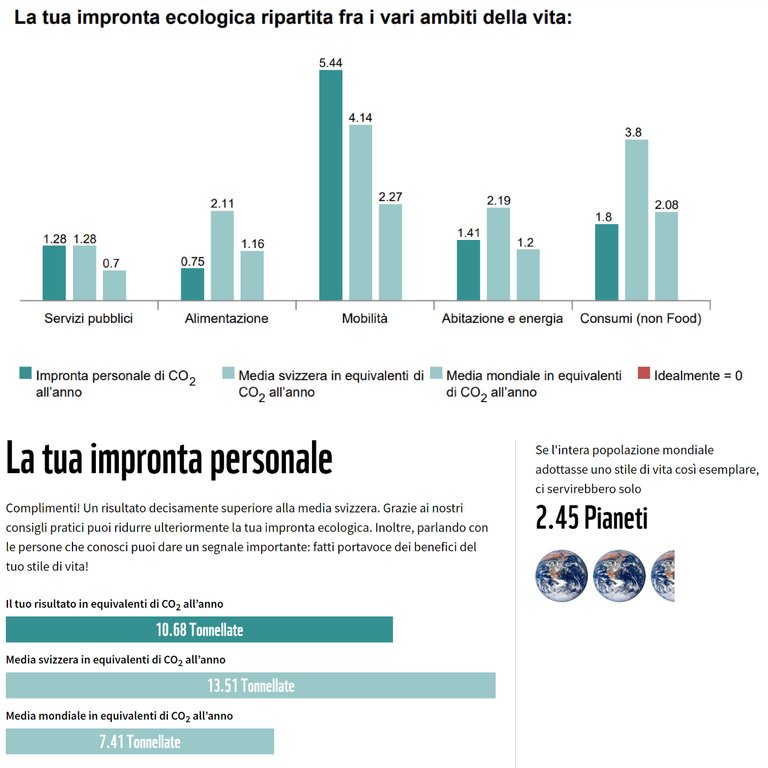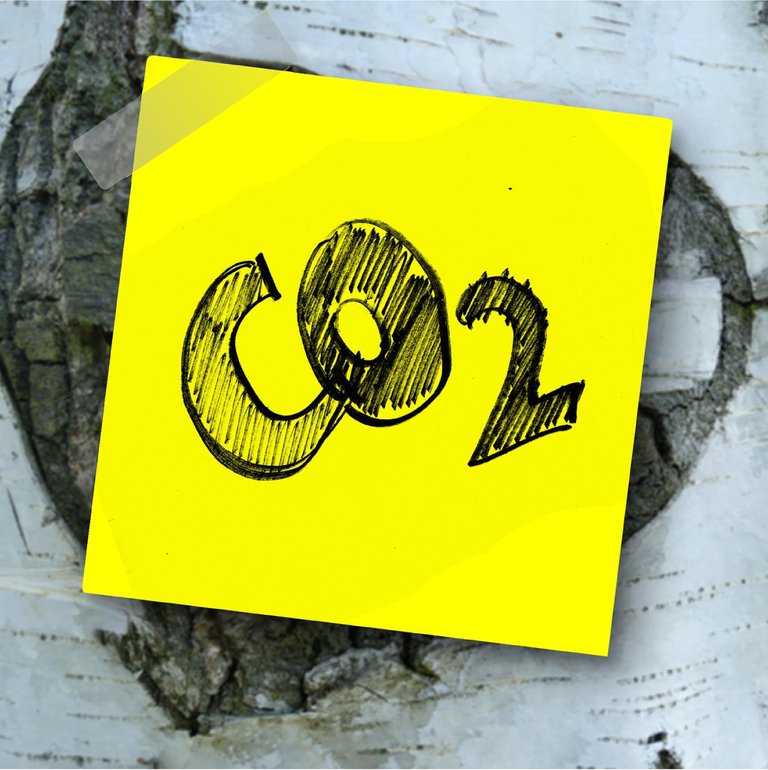Calculate your carbon footprint! - Calcola la tua impronta di carbonio!
Hello everyone!
I recently started attending a course in my university called "Environmental Analytical Chemistry". It is a very interesting course that aims to give the basic knowledge of the main chemical-analytical methodologies used in the analysis of inorganic ions, natural substances, metabolites, toxic in matrices of environmental interest such as water, soils and atmosphere!
I decided to include this course in my university career because I find that the topic is really interesting and also very current, given that every day you hear about topics such as global warming and pollution!
In addition, the topic interests me particularly because, for some years now, I have decided to change my lifestyle in order to minimize my environmental impact, adopting solutions such as the zero-waste philosophy and the vegetarian diet.
Carbon footprint
One of the most used methods to evaluate the emissions of greenhouse gas caused by a product, service, organization, event or individual is undoubtedly the calculation of the carbon footprint!
This is a parameter that takes into account the sum of all greenhouse gas emissions, defined as greenhouse gas (GHG):
- Carbon dioxide (hence the name of the technique);
- Natural gas;
- Nitrous oxide;
- Hydrofluorocarbons;
- Perfluorocarbons;
- Sulfur hexafloride.
Evaluation of the impact of a product
The sustainability of a product is an increasingly sought after feature by the consumer and, consequently, European companies have begun to take it into strong consideration.
In assessing sustainability, it is not only necessary to consider the object itself, but also a series of processes that take place before, during and after the use of the product. Disposal, in fact, is also a fundamental part of eco-sustainability and, if a product allows it to be included in a circular economy, its environmental impact will be greatly reduced.
The emissions that are considered for the purpose of calculating the carbon footprint of a product are, for example:
- Direct emissions of GHG from sources that belong to or are directly controlled by the company, such as fuel combustion in boilers, furnaces, vehicles, chemical production;
- GHG emission for the generation of electricity purchased and consumed by the company;
- Any other indirect emissions from sources not owned or controlled by the company, for example extraction and production of raw materials, transport, use and disposal of materials.
Evaluation of the individual issue
Have you ever wondered what your environmental impact is in terms of greenhouse gas emissions? I do and recently I discovered that there are many calculators online that allow you to analyze it!
Searching the web you will find plenty of them, I just report a couple:
- WWF (in Italian);
- Carbon Footprint (in English).
The calculators are very simple to use and, in the end, they also provide information on how to improve your impact with simple daily life choices. I find it a very interesting service!
My analysis
Here there are some examples of questions and the results of the calculation of my carbon footprint!
- How many times do you eat meat or fish dishes? Never (vegan, allergic)
- How often do you throw food away? Pratically never
- How much seasonal fruit and vegetables do you usually buy? About 75%
- How often do you consume milk or dairy products such as yogurt, cheese, butter or cream? About 1-3 times a week
- How many kilometers do you travel every year, by car or motorbike, for private reasons? Between 12 500-30 000 km
- At what temperature do you adjust your home heating? Not more than 19° C
--> "Your result in CO2 equivalents per year is 10.68 tons!
--> The Swiss average is 13.51 tons per year.
--> The world average is 7.41 tons per year.
--> If the whole population adopted this lifestyle, we would need 2.45 planets!"
OMG!
As you can see, I still have a lot of work to do!!
How did your test go? Thanks for the attention.
See you next time,
Delilha
ITA
Ciao a tutti!
Da poco ho iniziato a frequentare un corso nella mia università chiamato “Chimica analitica ambientale”. È un corso molto interessante che ha come scopo dare le conoscenze di base delle principali metodologie chimico-analitiche utilizzate nell'analisi di ioni inorganici, sostanze naturali, metaboliti, tossici in matrici di interesse ambientale come acqua, terreni e atmosfera!
Ho deciso di inserire questo corso nella mia carriera universitaria perché trovo che l’argomento si davvero interessante e anche molto attuale, dato che ogni giorno si sente parlare di argomenti come surriscaldamento globale e inquinamento!
Inoltre, l’argomento mi interessa particolarmente perché, da qualche anno a questa parte, ho deciso di modificare il mio stile di vita al fine di minimizzare il mio impatto ambientale, adottando soluzioni come la filosofia zero-waste e la dieta vegetariana.
Impronta di carbonio
Uno dei metodi più utilizzati per valutare le emissioni di gas serra causate da un prodotto, da un servizio, da un'organizzazione, da un evento o da un individuo è senza dubbio il calcolo dell’impronta di carbonio!
Si tratta di un parametro che tiene in considerazione la somma di tutte le emissioni di gas serra, definite greenhouse gas (GHG):
- Anidride carbonica (da cui il nome della tecnica);
- Metano;
- Ossido nitroso;
- Idrofluorocarburi;
- Perfluorocarburi;
- Esafloruro di zolfo.
Valutazione dell’emissione di un prodotto
La sostenibilità di un prodotto è una caratteristica sempre più ricercata dal consumatore e, di conseguenza, le aziende europee hanno cominciato a tenerla fortemente in considerazione.
Nella valutazione della sostenibilità non è necessario solo considerare l’oggetto in sé, ma anche una serie di processi che avvengono prima, durante e dopo l’utilizzo del prodotto. Anche lo smaltimento, infatti, è una parte fondamentale dell’eco-sostenibilità e, se un prodotto permette di essere inserito in un’economia circolare, ne si ridurrà moltissimo l’impatto ambientale.
Le emissioni che vengono considerate ai fini del calcolo dell’impronta di carbonio di un prodotto sono, ad esempio:
- Emissioni dirette di GHG da fonti che appartengono o sono direttamente controllate dall’azienda, come combustione di combustibile in caldaie, fornaci, veicoli, produzione chimica;
- Emissione di GHG per la generazione dell’elettricità acquistata e consumata dall’azienda;
- Ogni altra emissione indiretta da fonti non possedute o controllate dall’azienda, ad esempio estrazione e produzione di materie prime, trasporti, uso e smaltimento di materiali.
Valutazione dell’emissione individuale
Vi siete mai chiesti quali sia il vostro impatto ambientale dal punto di vista delle emissioni di gas serra? Io sì e recentemente ho scoperto che online esistono numerosi calcolatori che permettono di analizzarlo!
Cercando sul web ne troverete a bizzeffe, io ne riporto giusto un paio:
- WWF (in Italiano);
- Carbon Footprint (in Inglese).
I calcolatori sono molto semplici da utilizzare e, alla fine, forniscono anche delle informazioni su come migliorare il proprio impatto con le semplici scelte di vita quotidiane. Lo trovo un servizio molto interessante!
La mia analisi
Ecco alcuni screen di esempi di domande e i risultati del calcolo della mia impronta al carbonio!




OMG!
Come vedete, ho ancora decisamente molto lavoro da fare!!
Com’è andato il vostro test? Grazie per l’attenzione.
Alla prossima,
Delilha
Fonti – Sources: “Sustainability: How the Cosmetics Industry is Greening Up” A. Sahota; Wikipedia ; WWF.




Fichissimo il sito per vedere quanto si emette, devo provarci!
!discovery 40
Poi fammi sapere eh!
Questo post è stato condiviso e votato all'interno del discord del team curatori di discovery-it Entra nella nostra community! hive-193212
This post was shared and voted inside the discord by the curators team of discovery-it. Join our community! hive-193212
Manually curated by the Qurator Team in partnership with @discovery-blog.
Keep up the good work!
Thank you :)
Congratulations @delilhavores! You have completed the following achievement on the Hive blockchain and have been rewarded with new badge(s) :
You can view your badges on your board and compare to others on the Ranking
If you no longer want to receive notifications, reply to this comment with the word
STOPDo not miss the last post from @hivebuzz:
Vote for us as a witness to get one more badge and upvotes from us with more power!
Super interessante, non ne avevo mai sentito parlare! Soprattutto mi sorprende come viene calcolata e quali sono indicativamente i dati che servono!
Mi fa piacere che tu abbia trovato interessante il mio post :)
Effettivamente, l'impronta di carbonio non è un parametro di cui si sente parlare spesso, però allo stesso tempo è molto importante.
Grazie per il commento!
Thanks for your contribution to the STEMsocial community. Feel free to join us on discord to get to know the rest of us!
Please consider supporting our funding proposal, approving our witness (@stem.witness) or delegating to the @steemstem account (for some ROI).
Please consider using the STEMsocial app app and including @stemsocial as a beneficiary to get a stronger support.
Thanks :)
Interessante andrò a fare il test ma sono terrorizzato dal risultato probabilmente mi ci vorrebbero 500 pianeti. Un abbraccio.
Effettivamente io ci sono rimasta un po' male! Ahah
Però è in ogni caso interessante perché, alla fine del test, sono forniti dei consigli su come diminuire il proprio impatto ambientale e quindi non è mai troppo tardi per migliorare :)
La consapevolezza è sempre il primo passo!
Grazie per il tuo supporto. A presto
This post was shared in the Curation Collective Discord community for curators, and upvoted and reblogged by the @c-squared community account after manual review.
@c-squared runs a community witness. Please consider using one of your witness votes on us here
Thank you :)
Link all'articolo sulla Pagina Facebook di Hive Italia
Grazie!
A te, per i tuoi sempre preziosi post.
@delilhavores, In my opinion you've come up with Unique Subject here and after you've became the part of Calculations in a way you've made this subject Personalised one. Thank you so much for sharing these Subjects, Research and Results.
Have a wonderful time ahead and stay blessed.
I'm always very happy when someone appreciate my posts. Thank you so much! :)
Welcome. 🙂